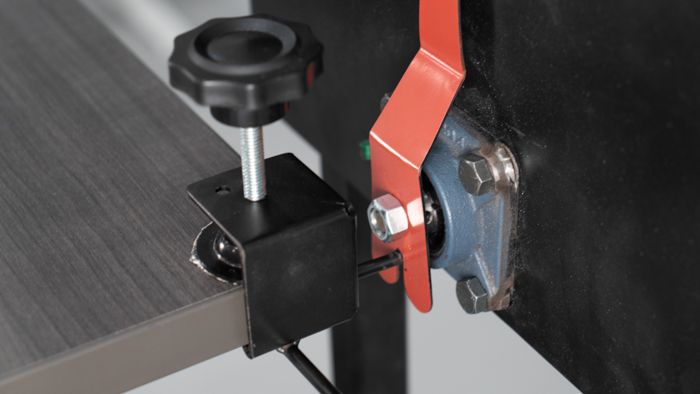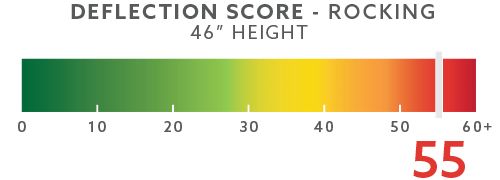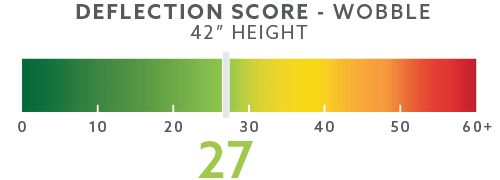Since we launched our first stability testing videos, we’ve always wanted to create a more standardized way to test the stability of standing desks. Our goal for the learning center has always been about honesty and transparency. Without a way to accurately measure a desks motion, it can be hard for people that are skeptical of our approach to trust what we are doing.
After a lot of conversations with our OEM, K&A Mfg., the WobbleMeter was born. With the use of the WobbleMeter, we are able to provide an objective method of measuring a standing desks wobble. This allows us to accurately compare one brand against another when looking at how stable a frame is. The goal is to help consumers create a baseline for what is stable enough for their specific needs when searching for the best standing desk for them.
Full Disclaimer: We are an office furniture dealer and sell some of the products we review. To learn more about the products we sell, our review process and why you can trust us, please visit: Why we’re different. Who is BTOD.com and The Breakroom Blog?
Our WobbleMeter Test Setup
All three tests are performed with a 50 lbs. dumbbell that is placed at the back of center of the table’s surface. For 30” deep surfaces, it is centered at a point of 19.5” back from the front edge and at 24” from the left and right edges.

We have a bracket that is connected to the back right corner of the desk’s work surface. Attached to the bracket are two pins, one for each direction of testing. This design allows us to perform the rocking and wobble testing without having to move the bracket and ensures all desks are tested at the same location. This bracket is also used for attaching the pull force gauge.



All desks are placed on a 4′ x 6′ Cintas XTRACTION mat that is low pile with a rubber backing. This is done to hold all bases firmly in place and mimic low pile carpet commonly found in a commercial office.

What We Score
When we test standing desks for stability, we use three main tests to come to our conclusion. Each is described below to help understand the results and how they might impact your work.
Rocking Deflection Test
Our front to back rocking deflection test is done at three different heights. The first is at a 30” height, which almost all standing desks are stable. We also test at 42” and 46” tall. For each height, we apply three different amounts of force: 5, 10 and 15 lbs (+/- .25lbs). We take each of the scores and add them together to get the overall rocking deflection score for each height.
Example Rocking Score @ 46″

| Pull Force | 5 lbs | 10 lbs | 15 lbs | Total |
| 9 | 15 | 31 | 55 |
Wobble Deflection Test
Our wobble deflection score is done at the same three heights as the rocking test. Much like the rocking test, 30” is a height where most standing desks are stable. For each height, we apply three different amounts of force: 5, 10 and 15 lbs. We take each of the scores, add them together and get the wobble deflection score for each height.
Example Wobble Score @ 42″

| Pull Force | 5 lbs | 10 lbs | 15 lbs | Total |
| 3 | 7 | 17 | 27 |
What The Score Ranges Mean

0-20 = Excellent Stability
Almost all of the desks tested at sitting height will score between 0-20. This is our baseline for excellent stability since most standing desks provide excellent stability at their lowest heights. Users in this range will not notice motion.
21-30 = Very Good to Good Stability
Between 20-30 most users will not notice the small amount of motion in this range.
31-40 = Good to Fair Stability
Between 31-40 some users may begin to notice the amount of motion in this range. This is especially true the closer the score is to 40.
41-50 = Fair to Bad Stability
Between 41-50 most users will notice the amount of motion in this range. This is especially true the closer the score is to 50.
51-60+ = Very Bad Stability
51-60+ all users will notice the amount of motion in this range. This is especially true for scores that are above 60.
What We Don’t Score
True WobbleTest
The True WobbleTest is performed at two different heights; 42” and 46” tall. Attaching the pull force gauge, we apply between 8-10 lbs of pulling force and continue to pull at that force. Because this is harder to get a consistent measurement, we do not record these scores. Instead, we provide a video to give an idea of how the table reacts to the force applied.
Understanding The Results
Much like our original stability testing videos, we are looking at two specific motions. The first is the front to back rocking motion and the second is a side to side wobble motion. We test each desk at 30”, 42” and 46” tall. These heights are a good point for most people to get a general idea of how a desk will impact them sitting and standing.
The scale is rated at 0-84 on both sides of the meter. The lower the number, the more stable the frame is likely to be in that direction. Comparing these results with other desks is the best way to understand what is the most stable option.
Our 30” test is to provide a baseline since the majority of the standing desks we tested are most stable at sitting height. These tests allow you to see how they all perform at a lower height. The next test is a 42” height which is for users that are around 5’8” to 5’9 tall. Last, we test at 46” tall, which is a height that is recommended for users that are around the 6’3” to 6’4” mark. With all of these tests, you should be able to get a better idea of how a desk will perform for you.
Lastly, we include a video that shows our true wobble test, where we wobble the desk with 10 lbs. of force at 42” and 46”. This video better illustrates how the deflection rating directly impacts the stability of the frame. The higher the deflection scores, the more amplified the True WobbleTest score will be. When a desk does not use a cross support system or upper wedge system, the True WobbleTest scores can be very high.
How This Impacts Your Work
So what does all of this mean? Will these results matter to you? These are great questions and honestly, it all depends on the individual. Some users tolerance to wobble and rocking motions will be higher than others. That is why you see wide-ranging feedback online about stability.
The truth is that it doesn’t take a lot of motion to be annoying. Think about your experiences with a wobbly restaurant table or a high-top pub tables. Most of the time they only wobble side to side ¼” to ½” at most, but it is enough to become annoying, causing you to focus on fixing the wobble.
Unfortunately, fixing a standing desks stability issues isn’t as easy as stuffing napkins under the foot. They need to be manufactured with a focus on stability. We suggest you think about the type of work you will be performing at your desk and your personal preference for stability. Using this information you should able to use our WobbleTest results to narrow down a standing desk to fit your stability needs.




